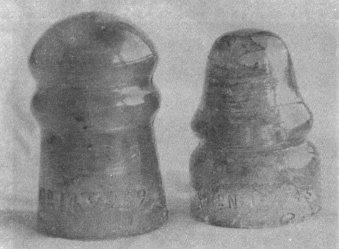Research Division
Reprinted from "INSULATORS - Crown Jewels of the Wire", September 1974, page 35
Gentlemen,
Mr. Tibbits, in answer to a letter I sent him, suggested that we write you
for information about an insulator that my young cousin, Todd Shattuck Tapasak,
found in Sayville, Long Island, New York. Mr. Tibbits wrote that he has not seen
this insulator.

I am enclosing a sketch that Todd made, along with a polaroid photograph. The
insulator was found in a dump in Sayville, when he was digging for bottles. Todd
is not an insulator collector. I started to collect, but did not continue, and
so when Todd showed me his find, I was very curious about it. We both hope that
someone will have some knowledge of this particular one. We do not think that it
is a "phony". It surely does not look like one.
Sincerely,
Mrs. John C. Griek

- - - - - - - - -
Description of insulator: Opal? Glass, height 4", bottom outside
dimensions, 2-1/4", inside, 1-3/4", two-part mold, stop and go sharp
spiral threading, four spirals + 1-1/2". On top is a round spot
1-3/16" wide that has the appearance of a cap and is slightly raised.
- - - - - - - - -
Dear Mrs. Griek,
At last we have tracked down some information on your insulator. Marion
Milholland, author of "Most About Glass Insulators", writes that two
others have been found on a building in New York State. One insulator was
cemented on the pin so tight that the metal pin had to be cut off with a hack
saw before being taken from the line. The other one Mr. Haley was able to remove
from the fastening without much effort. Since these insulators are unembossed,
Mr. Milholland assigned for the time being the name "Haley" in an
effort to give Mr. Haley credit for the find. The insulator you have makes three
found so far, and it is considered to be a rare jewel. Thanks for sharing your
find with us.
Dora

Dear Editor,
I bought the above insulator at Houston, Texas last month. Mr. Milholland said
he had never seen one. But he said he was going to try to get it in his new
book.
This insulator is mint in every way - the metal caps, the screw, and the
glass. I am very proud of it, and it adds much to my collection. I call it
"The Otis Pat." It's a lightning rod insulator. I would like to let
everyone see it. I don't know how good it is, but I like it very much.
Thanks,
A. L. Rash
Rt. 3 Box 669
Silsbee, Texas 77656

Dear Dora,
I am enclosing a picture of two insulators (CD 126 and CD 133) that might
interest your readers. As far as I know, there aren't too many around. I know of
only one other 133, and Milholland has it. I don't know how many of the 126's
there are, but I would guess not over 15.
The color of the RD insulators that I have seen has been milky green. The 126
in the picture is much milkier than the 133. It looks almost like a jade in the
photo, but it is not. You can see into it, if you know what I mean. One odd fact
about these insulators is that they are ground on the bottom like the tops of
old canning jars.
I am doing a little research on RD insulators, and I would like to hear from
anyone who has or has had one, where they found it, and any information they
might have. Also, does anyone have any different CD RD insulators?
Sincerely,
Hank Golet
Milke Creek Rd.
Old Lyme, CT 06371
|
